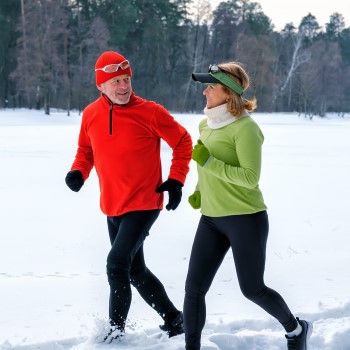Read the original article here >
Southwestern Vermont Medical Center
Thursday, December 14, 2023
While the thought of heading outside for a little exercise in freezing temperatures may not sound all that appealing, winter workouts do offer benefits you don’t get in summer. For instance, exercising in the cold forces your body to work harder to stay warm and burns more calories. Plus, exercising outdoors in the winter helps you get exposure to sunlight, which may help ward off seasonal affective disorder, a type of depression often experienced in the winter.
Except for extreme temperature dips (see point #5 below), exercising outside in the winter can be perfectly safe. However, it does require some extra precautions. Follow these tips to stay fit and safe:
1. Dress warmly
Keeping your body and muscles warm is key to exercise at any time of year but is especially important in the winter. Frigid temps can lead to stiff muscles and poses a risk of frostbite. Be sure to keep your hands, feet, and ears covered when outside and wear clothing you can easily take on and off as needed. While you don’t need to spend hundreds of dollars on winter wear, you do want to look for fabrics that draw sweat away from your body. Always avoid cotton which will retain moisture and make you colder. Ideally, your top layer should be made with a waterproof, breathable fabric.
2. Drink plenty of water
Both sweating and spending time in dry winter air can make you dehydrated. Be sure to drink water before, during, and after your workout.
3. Warm up and stretch before exercising
Cold muscles are at a greater risk for strains and injuries. Be sure to do a 5–10-minute warm-up indoors or out before exercising. Jumping jacks, front and side lunges, squats and squat jumps will help your body transition from rest to action. Once your muscles are warm, you should do some gentle stretches before diving into your workout. Stretching is also recommended when you’re done working out.
4. Wear sunscreen
Sunscreen isn’t just for the beach. In fact, your risk of sunburn can go up in the winter due to sunlight reflecting off the snow. Be sure to cover all exposed skin with a product that blocks both UVA and UVB rays plus a lip balm with sunscreen.
5. Play it safe
To avoid hypothermia and frostbite, move your workout inside if the temperature drops below 0°F or the wind chill reaches -17°F. According to the National Weather Service, you are unlikely to get frostbite when the temperature is above 5°F and the wind blows at less than 25 mph, but that risk increases substantially as the temperature drops and wind speeds pick up. Exposed skin can develop frostbite in 30 minutes at a wind chill of -19°F.
NOTE: Anyone who has any medical conditions such Raynaud’s, asthma, or other respiratory issues should consult with their primary care physician before engaging in any outdoor winter exercise.

